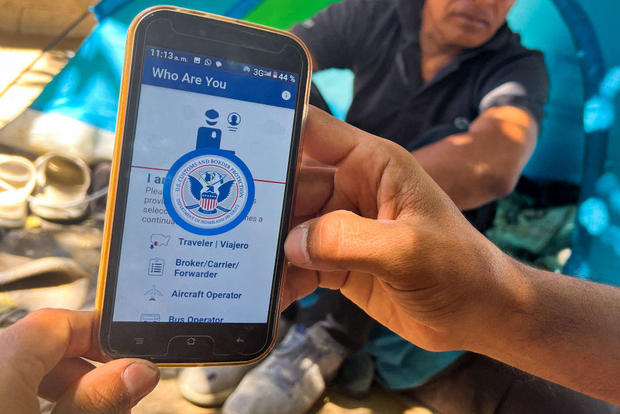What is Title 8, and what has changed along the U.S.-Mexico border after Title 42's expiration?
Posted by Temmy
Wed, May 17, 2023 2:27pm

A U.S. Border Patrol agent keeps watch as immigrants enter a vehicle to be transported from a makeshift camp between the U.S. and Mexico on May 13, 2023, in San Diego, California. GETTY IMAGES
The expiration of the Title 42 pandemic emergency rules along the U.S.-Mexico border on May 11 means that all migrants and asylum-seekers who reach American soil need to be processed under Title 8, a set of complex and decades-old immigration laws.
On paper, the processing of migrants who enter U.S. border custody has returned to pre-pandemic protocols. But the current levels of migration to the southern border are at historic highs, making the processing of migrants anything but normal.
Now that Title 42 is no longer in place, U.S. asylum law, which dates back to 1980, requires officials to, at the very least, give migrants who say they are fleeing danger an initial interview. That does not mean all migrants will be allowed to stay in the U.S.
In fact, the Biden administration has enacted a rule to make it more difficult for migrants to qualify for asylum in the first place and easier for the government to deport them. It is pairing that restriction and increased deportations with programs that allow migrants to enter the U.S. legally if they meet certain requirements.
Here's how migrants will be processed under Title 8, for at least the near-future.
What is Title 8, and how is it different from Title 42?
Both Title 8 and Title 42 refer to sections of the U.S. Code, which categorizes all permanent federal laws. Title 8 encompasses laws concerning "Aliens And Nationality," while Title 42 includes laws about "The Public Health And Welfare."
The now-expired Title 42 order was based on a 1944 public health law that empowers the government to ban people or products from countries if there is a "serious danger" they could spread a contagious disease. The Trump administration first issued the order at the beginning of the COVID-19 pandemic to summarily expel migrants without adhering to processing requirements under U.S. immigration and asylum laws.
Migrants who were processed under Title 42 were not allowed to request asylum. They were quickly processed and expelled from the U.S., typically by being turned back to Mexico. In more limited cases, they were flown to their home countries.
Unlike formal deportations under Title 8, expulsions under Title 42 did not impose immigration or criminal consequences on migrants, meaning those expelled to Mexico could repeatedly try to cross the border. Under Title 8, migrants who are deported are banned from entering the U.S. for at least five years. And if they reenter the U.S. unlawfully, they could face charges and jail time.
While those processed under Title 8 are typically deported to their home countries, Mexico recently agreed to accept Cuban, Haitian, Nicaraguan and Venezuelan deportees at the request of the U.S., which cannot conduct large numbers of deportations to these migrants' home countries because of diplomatic and logistical reasons.
Who can seek asylum now?
U.S. asylum law gives migrants the legal right to request asylum if they are physically on American soil, regardless of how they entered the country.
Under "expedited removal" proceedings, a fast-track deportation process the Biden administration is expanding following Title 42's termination, migrants can be quickly deported, without a court hearing, if they don't claim asylum. If migrants processed under expedited removal claim asylum, they must pass an initial screening with an asylum officer to avoid deportation.
Typically, these initial screenings, known as "credible fear" interviews, have had generous standards. But the Biden administration's recently enacted restriction on asylum has raised the screenings' passing threshold for migrants who enter the country illegally after failing to seek asylum in a third country en route to the U.S. The new rules are designed to ensure most non-Mexican asylum-seekers are rejected, deported and banished from the U.S. for five years.
Not all migrants will be processed under expedited removal, since the government does not have enough asylum officers, detention facilities and deportation flights to make everyone who crosses the southern border illegally subject to the policy.
Some migrants will be detained in long-term detention centers pending a review of their cases. Others will be released with a notice to appear in court. Another policy, in which migrants would be released with instructions to check in with immigration officials to receive a court date at their final destinations, has been blocked in federal court.
While migrants placed in court proceedings can be ordered deported if they don't qualify for asylum or don't show up to hearings, they often wait years for a decision because the massively backlogged immigration court system is handling over 2 million unsettled cases.
Are adults processed differently than families and children?
Yes. Migrant adults traveling without children are expected to be disproportionately affected by the more stringent measures announced by the Biden administration, since the U.S. can detain larger numbers of single adults while officials determine whether they should be deported.
Single adults processed under expedited removal will be deported if they don't claim asylum and kept in federal custody if they do to undergo phone screenings with asylum officers. Immigration and Customs Enforcement recently expanded its detention capacity to be able to hold several thousand additional adults.
While the new asylum restriction applies to both adults and families, most parents and children traveling together are likely to be released with court notices or a scheduled interview with an asylum officer since the Biden administration discontinued family immigration detention. However, some parents will be required to undergo GPS tracking and subject to home curfews.
Migrant adults and families who pass initial screenings with asylum officers will be allowed to have a day in court. Like those released with court notices, they will need to prove they are fleeing persecution due to their race, nationality, religion, politics or membership in a social group to secure asylum, which would allow them to stay in the U.S. permanently.
Unaccompanied migrant children are categorically exempted from expedited removal and the restriction on asylum. A 2008 law requires U.S. border officials to transfer all unaccompanied migrant children who are not from Mexico to the Department of Health and Human Services (HHS) within 72 hours.
HHS houses these children in shelters, foster homes and other housing facilities until they turn 18 or are claimed by a U.S.-based sponsor, who is typically a family member, such as a parent or grandparent. While in the U.S., they can apply for asylum or visas for abused or abandoned children.
How can migrants enter the U.S. legally?
The Biden administration has also expanded opportunities for migrants to come to the U.S. with the government's permission, betting that doing so will dissuade illegal border entries.
Migrants in northern and central Mexico can use a government phone app, known as CBP One, to try to secure an appointment to enter the U.S. at a port of entry along the southern border. The U.S. is distributing roughly 1,000 appointments per day. Those with an appointment are generally allowed to enter the U.S. after some vetting, released and given a court notice.
Cuban, Haitian, Nicaraguan and Venezuelan migrants also have the option of flying to the U.S. if U.S.-based individuals agree to financially sponsor them. The Biden administration's program allows for up to 30,000 of these arrivals per month.
Migrants who use the CBP One app or the sponsorship program are exempted from the asylum restriction and can apply for work permits and asylum.
The Biden administration recently announced a program to allow up to 100,000 Central Americans and Colombians to fly to the U.S. if they have approved visa sponsorship requests filed by their American citizen or resident relatives. It also said it will set up dozens of processing centers in Latin America to screen migrants for eligibility to be resettled in the U.S., Canada, Spain or the hosting countries.

A migrant shows the CBP One App from Customs and Border Protection, which is used to apply for an appointment to claim asylum, in Ciudad Juárez, Mexico, on May 10, 2023. GILLES CLARENNE/AFP VIA GETTY IMAGES
|








